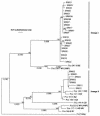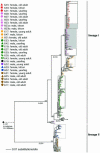Epidemiology, genetic diversity, and evolution of endemic feline immunodeficiency virus in a population of wild cougars
- PMID: 12915571
- PMCID: PMC187433
- DOI: 10.1128/jvi.77.17.9578-9589.2003
Epidemiology, genetic diversity, and evolution of endemic feline immunodeficiency virus in a population of wild cougars
Abstract
Within the large body of research on retroviruses, the distribution and evolution of endemic retroviruses in natural host populations have so far received little attention. In this study, the epidemiology, genetic diversity, and molecular evolution of feline immunodeficiency virus specific to cougars (FIVpco) was examined using blood samples collected over several years from a free-ranging cougar population in the western United States. The virus prevalence was 58% in this population (n = 52) and increased significantly with host age. Based on phylogenetic analysis of fragments of envelope (env) and polymerase (pol) genes, two genetically distinct lineages of FIVpco were found to cooccur in the population but not in the same individuals. Within each of the virus lineages, geographically nearby isolates formed monophyletic clusters of closely related viruses. Sequence diversity for env within a host rarely exceeded 1%, and the evolution of this gene was dominated by purifying selection. For both pol and env, our data indicate mean rates of molecular evolution of 1 to 3% per 10 years. These results support the premise that FIVpco is well adapted to its cougar host and provide a basis for comparing lentivirus evolution in endemic and epidemic infections in natural hosts.
Figures





Similar articles
-
Recombination in feline immunodeficiency virus genomes from naturally infected cougars.Virology. 2007 Aug 1;364(2):362-70. doi: 10.1016/j.virol.2007.03.023. Epub 2007 Apr 18. Virology. 2007. PMID: 17445856 Free PMC article.
-
Evolution of the long terminal repeat and accessory genes of feline immunodeficiency virus genomes from naturally infected cougars.Virology. 2008 Jan 5;370(1):55-62. doi: 10.1016/j.virol.2007.08.024. Epub 2007 Sep 29. Virology. 2008. PMID: 17904608 Free PMC article.
-
Quantification of Feline immunodeficiency virus (FIVpco) in peripheral blood mononuclear cells, lymph nodes and plasma of naturally infected cougars.J Gen Virol. 2006 Apr;87(Pt 4):967-975. doi: 10.1099/vir.0.81450-0. J Gen Virol. 2006. PMID: 16528047
-
The molecular biology and evolution of feline immunodeficiency viruses of cougars.Vet Immunol Immunopathol. 2008 May 15;123(1-2):154-8. doi: 10.1016/j.vetimm.2008.01.022. Epub 2008 Jan 19. Vet Immunol Immunopathol. 2008. PMID: 18295904 Free PMC article. Review.
-
Vaccination of cats with recombinant envelope glycoprotein of feline immunodeficiency virus: decreased viral load after challenge infection.AIDS Res Hum Retroviruses. 1996 Mar 20;12(5):431-3. doi: 10.1089/aid.1996.12.431. AIDS Res Hum Retroviruses. 1996. PMID: 8882327 Review. No abstract available.
Cited by
-
Antagonistic pleiotropy and fitness trade-offs reveal specialist and generalist traits in strains of canine distemper virus.PLoS One. 2012;7(12):e50955. doi: 10.1371/journal.pone.0050955. Epub 2012 Dec 11. PLoS One. 2012. PMID: 23239996 Free PMC article.
-
Plagues and adaptation: Lessons from the Felidae models for SARS and AIDS.Biol Conserv. 2006 Aug;131(2):255-267. doi: 10.1016/j.biocon.2006.05.001. Epub 2006 Jun 6. Biol Conserv. 2006. PMID: 32226081 Free PMC article.
-
Evolution of feline immunodeficiency virus in Felidae: implications for human health and wildlife ecology.Vet Immunol Immunopathol. 2008 May 15;123(1-2):32-44. doi: 10.1016/j.vetimm.2008.01.010. Epub 2008 Jan 19. Vet Immunol Immunopathol. 2008. PMID: 18359092 Free PMC article. Review.
-
Recombination in feline immunodeficiency virus genomes from naturally infected cougars.Virology. 2007 Aug 1;364(2):362-70. doi: 10.1016/j.virol.2007.03.023. Epub 2007 Apr 18. Virology. 2007. PMID: 17445856 Free PMC article.
-
Variation in Intra-individual Lentiviral Evolution Rates: a Systematic Review of Human, Nonhuman Primate, and Felid Species.J Virol. 2019 Jul 30;93(16):e00538-19. doi: 10.1128/JVI.00538-19. Print 2019 Aug 15. J Virol. 2019. PMID: 31167917 Free PMC article.
References
-
- Bachmann, M. H., C. Mathiason-Dubard, G. H. Learn, A. G. Rodrigo, D. L. Sodora, P. Mazzetti, E. A. Hoover, and J. I. Mullins. 1997. Genetic diversity of feline immunodeficiency virus: dual infection, recombination, and distinct evolutionary rates among envelope sequence clades. J. Virol. 71:4241-4253. - PMC - PubMed
-
- Beier, P. 1991. Cougar attacks on humans in the United States and Canada. Wildl. Soc. Bull. 19:403-412.
Publication types
MeSH terms
Substances
LinkOut - more resources
Full Text Sources

